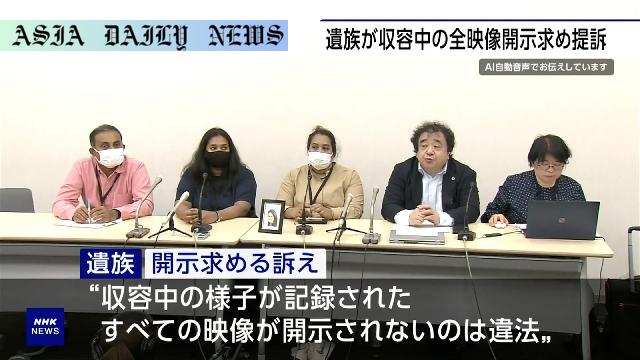Immigration Custody Death: Family demands full release of surveillance footage after woman’s tragic death in Japan detention.
The family of Wishma Sandamali demands justice over her death in Japanese immigration custody.
Only 5 out of 295 hours of surveillance footage has been released, sparking controversy.
The Nagoya bureau cites ‘security information’ as the reason for withholding footage.

Background of the Tragic Immigration Custody Incident
On March 6, 2021, a Sri Lankan woman named Wishma Sandamali tragically passed away in a Japanese immigration detention facility located in Nagoya City. Wishma, only 33 years old, reportedly complained of health issues before her untimely death. Her case has since sparked outrage and ignited a heated discussion surrounding the treatment of detainees in immigration facilities, the transparency of related institutions, and the responsibility of the state in safeguarding individuals under its care.
The family has long demanded answers, and the release of surveillance footage captured during her detention has become a central component of their quest for justice. Despite over 295 hours of footage being recorded, authorities have only released about five hours of it as evidence in court proceedings. This perceived lack of transparency has prompted additional legal action from Wishma’s family, culminating in a lawsuit filed on October 17, 2023, in the Tokyo District Court. They are demanding access to the full video archive, believing the material might shed light on the events leading up to her death.
Family’s Perspective and Persistent Efforts for Justice
Wishma’s family, especially her sister Poornima, has been vocal about their desire to uncover the truth. Poornima has emphasized that the surveillance footage belongs to their family rather than the state. Her arguments reflect not only the pain of losing a loved one in unclear circumstances but also a broader critique of the opacity within Japanese immigration operations. For the family, the refusal of the Nagoya Regional Immigration Services Bureau to release more of the footage is both a personal and systemic failure.
The family initially sought state redress through a lawsuit filed in 2022 with the Nagoya District Court. However, the slow progress and the unwillingness of the authorities to provide greater insights into the incident have only deepened their grievances. While the Nagoya bureau has referenced concerns about “security information” and operational integrity as its justification for withholding the footage, such arguments have done little to pacify the family or broader public concerns over accountability.
Legal and Ethical Considerations Regarding Footage Release
One of the critical points of contention in this case is the balance between institutional security and transparency. The Bureau maintains that releasing the entire 295 hours of footage could jeopardize their operational practices or even disrupt order within immigration facilities. While this argument might resonate within specific bureaucratic contexts, it fails to address the family’s sense of injustice and the public demand for accountability.
The ethical question arising is whether the disclosure of such evidence should be dictated solely by institutional priorities when significant allegations of neglect or misconduct exist. Wishma’s death, which has drawn international attention, underlines the responsibility that states have in ensuring transparent governance. Without an independent and full investigation, credibility and trust in the related institutions may erode further, inviting criticism both locally and internationally.
Implications for Immigration Policies and Systems
The case also raises larger questions about immigration detention policies in Japan. Japan has often faced scrutiny for its strict and opaque immigration policies, and Wishma’s case has become emblematic of these ongoing challenges. Treating detainees humanely, offering medical attention when needed, and ensuring clarity in custody procedures are essential for maintaining the integrity of immigration systems.
Additionally, there is a growing call from activists and human rights organizations for systemic reforms based on Wishma’s tragic demise. Such reforms could include third-party oversight, clearer communication of detainees’ rights, and better medical facilities within detention centers. Without these necessary measures, vulnerable individuals like Wishma might continue to face risks in the future.
Commentary
The Price of Transparency: Why Wishma Sandamali’s Case Matters
Wishma Sandamali’s tragic case is a painful reminder of the human cost of systemic failures. Her sudden passing while in custody highlights the critical need for transparency, accountability, and humanity in institutions tasked with detaining vulnerable individuals. It is deeply troubling that, over two years since her death, her family continues to fight for basic information that could provide clarity about what happened.
Family’s Struggle for Justice
The resilience displayed by Wishma’s family, particularly her sister Poornima, is commendable. Their unwavering determination to seek and unearth the truth isn’t just about finding closure but also about preventing future tragedies for others in similar situations. They’ve been forced to confront bureaucratic obstacles and legal complexities at every turn, making their pursuit of justice an uphill battle.
The Need for Systemic Change
As much as this case is about the release of surveillance footage, it speaks to a broader issue of systemic reform in Japan’s immigration detention services. Treating detainees with respect and ensuring their medical wellbeing are non-negotiable aspects of humane governance. Without reforms, institutions risk losing public trust and may face increased scrutiny both domestically and globally.
The lesson here is clear: transparency and accountability must form the foundation of any state system, especially one that handles individuals in vulnerable and precarious situations. Human dignity should never be compromised, regardless of immigration status.


